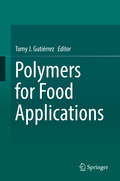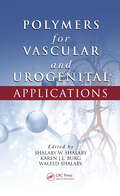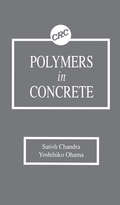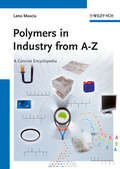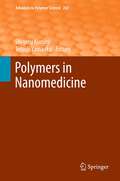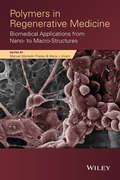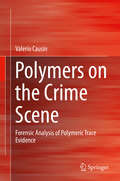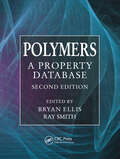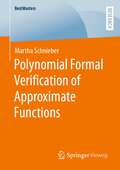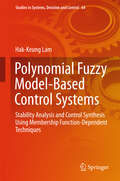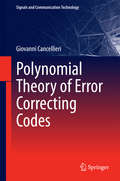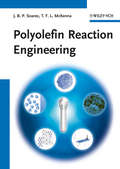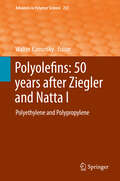- Table View
- List View
Polymers for Electronic Applications
by J.H. LaiThe object of this book is to review and to discuss some important applications of polymers in electronics. The first three chapters discuss the current primary applications of polymers in semiconductor device manufacturing: polymers as resist materials for integrated circuit fabrication, polyimides as electronics packaging materials, and polymers as integrated circuits encapsulates.
Polymers for Energy Storage and Conversion
by Vikas MittalOne of the first comprehensive books to focus on the role of polymers in the burgeoning energy materials marketPolymers are increasingly finding applications in the areas of energy storage and conversion. A number of recent advances in the control of the polymer molecular structure which allows the polymer properties to be more finely tuned have led to these advances and new applications. Polymers for Energy Storage and Conversion assimilates these advances in the form of a comprehensive text that includes the synthesis and properties of a large number of polymer systems for applications in areas such as lithium batteries, photovoltaics, and solar cells.Polymers for Energy Storage and Conversion:Introduces the structure and properties of polymer hydrogel with respect to its applications for low to intermediate temperature polymer electrolyte-based fuel cellsDescribes PVAc-based polymer blend electrolytes for lithium batteriesReviews lithium polymer batteries based on ionic liquidsProposes the concept of the solar cell with organic multiple quantum dots (MQDs)Discusses solvent effects in polymer-based organic photovoltaic devicesProvides an overview of the properties of the polymers that factor into their use for solar power, whether for niche applications or for large-scale harvestingReviews the use of macroporous organic polymers as promising materials for energy gas storageReadershipMaterials scientists working with energy materials, polymer engineers, chemists, and other scientists and engineers working with photovoltaics and batteries as well as in the solar and renewable energy sectors.
Polymers for Food Applications
by Tomy J. GutiérrezThis book presents an exhaustive review on the use of polymers for food applications. Polymer-based systems for food applications such as: films, foams, nano- and micro-encapsulated, emulsions, hydrogels, prebiotics, 3D food printing, edible polymers for the development of foods for people with special feeding regimes, sensors, among others, have been analyzed in this work.
Polymers for Light-emitting Devices and Displays
by Abdullah M. Asiri Mohd Imran Ahamed Rajender Boddula InamuddinPolymers for Light-Emitting Devices and Displays provides an in-depth overview of fabrication methods and unique properties of polymeric semiconductors, and their potential applications for LEDs including organic electronics, displays, and optoelectronics. Some of the chapter subjects include:• The newest polymeric materials and processes beyond the classical structure of PLED• Conjugated polymers and their application in the light-emitting diodes (OLEDs & PLEDs) as optoelectronic devices.• The novel work carried out on electrospun nanofibers used for LEDs.• The roles of diversified architectures, layers, components, and their structural modifications in determining efficiencies and parameters of PLEDs as high-performance devices.• Polymer liquid crystal devices (PLCs), their synthesis, and applications in various liquid crystal devices (LCs) and displays.• Reviews the state-of-art of materials and technologies to manufacture hybrid white light-emitting diodes based on inorganic light sources and organic wavelength converters.
Polymers for PEM Fuel Cells
by Hongting PuIncluding chemical, synthetic, and cross-disciplinary approaches; this book includes the necessary techniques and technologies to help readers better understand polymers for polymer electrolyte membrane (PEM) fuel cells. The methods in the book are essential to researchers and scientists in the field and will lead to further development in polymer and fuel cell technologies. * Provides complete, essential, and comprehensive overview of polymer applications for PEM fuel cells * Emphasizes state-of-the-art developments and methods, like PEMs for novel fuel cells and polymers for fuel cell catalysts * Includes detailed chapters on major topics, like PEM for direct liquid fuel cells and fluoropolymers and non-fluorinated polymers for PEM * Has relevance to a range of industries - like polymer engineering, materials, and green technology - involved with fuel cell technologies and R&D
Polymers for Packaging and Containers in Food Industry
by Lidia A. Sukhareva Vyacheslav S. Yakovlev Olga A. LegonkovaThis book delineates the scientific principles of design and fabrication of packaging materials for food as well as methods for structural modification and other techniques. It describes the main practical properties and applications of polymer materials and highlights the analysis of all processes taking place during formations and destruction of
Polymers for Vascular and Urogenital Applications (Advances in Polymeric Biomaterials)
by Karen J.L. Burg Shalaby W. Shalaby Waleed ShalabyIn a carefully crafted, multidisciplinary, skillfully focused format, Polymers for Vascular and Urogenital Applications covers attributes of polymers used for vascular, urological, and gynecological materials. It provides a brief analysis of how the use of polymers in vascular and urogenital applications has evolved in the past five decades and out
Polymers from Fossil and Renewable Resources: Scientific and Technological Comparison of Plastic Properties
by Francesco Ciardelli Monica Bertoldo Simona Bronco Elisa PassagliaThe book describes the development and commercialization of materials with viscoelastic properties, placing particular emphasis on the scientific and technological differences between plastics and bioplastics. The authors explain how to handle each of the two types of materials and determine the comparative environmental impact of the material life-cycle. The practical values of the overlapping aspects of the two types of materials from technical properties to eco-compatibility are also discussed.
Polymers from Plant Oils
by Alessandro Gandini Talita M. LacerdaThe purpose of this monograph is to provide a thorough outlook on the topic related to the synthesis and characterization of original macromolecular materials derived from plant oils, an important part of the broader steadily growing discipline of polymers from renewable resources. The interest in vegetable oils as sources of biodiesel and materials has witnessed a remarkable growth of scientific and industrial interest since the beginning of the third millennium responding to the pressing drive to implement sustainability in the energy and materials sectors. The book highlights the most relevant strategies being pursued to elaborate polymers derived from a variety of common oils, by direct activation or through chemical modifications yielding novel monomers. Because glycerol is the main byproduct of biodiesel production, it is treated here as the other logical source of macromolecular synthesis. Each of the different approaches is illustrated by an introductory layout of the underlying chemical mechanisms, followed by examples of notable achievements in terms of the properties and potential applications of the ensuing materials, which span a wide range of structures and performances. In particular, original pathways involving click-chemistry reactions as thiol-ene and Diels-Alder couplings and metathesis polymerizations are discussed and shown to reflect the involvement of a growing number of research programs worldwide. It is important to underline that the book is not a scientific review covering the details of all relevant literature, but instead a reasoned and well-documented presentation of the state-of-the-art aimed at professionals in the field of polymer science, as well as at both undergraduate and graduate students and, more generally at chemists interested in the rational exploitation of renewable resources.
Polymers in Concrete
by Yoshihiko Ohama Makoto Kawakami Kimio FukuzawaIncreasing attention is being given to the use of concrete-polymer composites as high performance and multi-functional materials in the construction industry, as well as in mechanical, electrical and chemical engineering. Particular interest is being given to these materials in Japan and other East Asian countries. This book forms the proceedings o
Polymers in Concrete
by Satish Chandra Yoshihiko OhamaThis broad-based, introductory reference provides excellent discussions regarding the hydration of Portland cement, durability problems in concrete, mechanisms of concrete deterioration, and interaction of polymers in concrete. It also covers properties of concrete with added polymers and practical applications of polymers in concrete. The historic background of polymers in building materials is examined, and a comprehensive comparison of natural vs. synthetic polymers is provided and conveniently summarized in a tabular format.
Polymers in Drug Delivery
by Ijeoma F. Uchegbu Andreas G. SchatzleinTogether, the nano explosion and the genomic revolution are ushering in a new frontier in drug delivery. In recent years we've seen how polymers can play a crucial role in controlling the rate of drug release, enhancing solubility and uptake, and limiting degradation and toxicity. In the very near future, they may well be used to deliver gene thera
Polymers in Energy Conversion and Storage
by Inamuddin Mohd Imran Ahamed Rajender Boddula Tariq AltalhiThe research and development activities in energy conversion and storage are playing a significant role in our daily lives owing to the rising interest in clean energy technologies to alleviate the fossil-fuel crisis. Polymers are used in energy conversion and storage technology due to their low-cost, softness, ductility and flexibility compared to carbon and inorganic materials. Polymers in Energy Conversion and Storage provides in-depth literature on the applicability of polymers in energy conversion and storage, history and progress, fabrication techniques, and potential applications.Highly accomplished experts review current and potential applications including hydrogen production, solar cells, photovoltaics, water splitting, fuel cells, supercapacitors and batteries. Chapters address the history and progress, fabrication techniques, and many applications within a framework of basic studies, novel research, and energy applications.Additional Features Include: Explores all types of energy applications based on polymers and its composites Provides an introduction and essential concepts tailored for the industrial and research community Details historical developments in the use of polymers in energy applications Discusses the advantages of polymers as electrolytes in batteries and fuel cells This book is an invaluable guide for students, professors, scientists and R&D industrial experts working in the field.
Polymers in Industry from A to Z: A Concise Encyclopedia
by Leno MasciaWe are surrounded by polymers: Whether it's to prepare a meal, use computer keyboards and mousepads, or step onto a new playground, you'll encounter a plastic product made of polymers.<P><P> Owing to the extraordinary range of properties accessible in polymeric materials, they play an essential and ubiquitous role in everyday life - from plastics and elastomers on the one hand to natural biopolymers such as DNA and proteins that are essential for life on the other. This desktop and library reference book provides a comprehensive yet concise overview of the materials, manufacture, structure and architecture, properties, processing, and applications of withing the field of polymers. The book offers a unique mix of theory and application, the essential personal reference for anyone studying or working within the field of polymers.
Polymers in Nanomedicine
by Tetsuji Yamaoka Shigeru KunugiFunctional Polymer Conjugates for Medicinal Nucleic Acid Delivery, by Ernst Wagner Biodegradable Nanoparticles as Vaccine Adjuvants and Delivery Systems: Regulation of Immune Responses by Nanoparticle-Based Vaccine, by Takami Akagi, Masanori Baba and Mitsuru Akashi Biodegradable Polymeric Assemblies for Biomedical Materials, by Yuichi Ohya, Akihiro Takahashi and Koji Nagahama PEGylation Technology in Nanomedicine, by Yutaka Ikeda and Yukio Nagasaki Cytocompatible Hydrogel Composed of Phospholipid Polymers for Regulation of Cell Functions, by Kazuhiko Ishihara, Yan Xu and Tomohiro Konno Design of Biointerfaces for Regenerative Medicine, by Yusuke Arima, Koichi Kato, Yuji Teramura and Hiroo Iwata Advances in Tissue Engineering Approaches to Treatment of Intervertebral Disc Degeneration: Cells and Polymeric Scaffolds for Nucleus Pulposus Regeneration, by Jeremy J. Mercuri and Dan T. Simionescu Functionalized Biocompatible Nanoparticles for Site-Specific Imaging and Therapeutics, by Ranu K. Dutta, Prashant K. Sharma, Hisatoshi Kobayashi and Avinash C. Pandey
Polymers in Regenerative Medicine
by Manuel Monleon Pradas Maria J. VicentBiomedical applications of Polymers from Scaffolds toNanostructuresThe ability of polymers to span wide ranges of mechanicalproperties and morph into desired shapes makes them useful for avariety of applications, including scaffolds, self-assemblingmaterials, and nanomedicines. With an interdisciplinary list ofsubjects and contributors, this book overviews the biomedicalapplications of polymers and focuses on the aspect of regenerativemedicine. Chapters also cover fundamentals, theories, and tools forscientists to apply polymers in the following ways:Matrix protein interactions with synthetic surfacesMethods and materials for cell scaffoldsComplex cell-materials microenvironments in bioreactorsPolymer therapeutics as nano-sized medicines for tissuerepair Functionalized mesoporous materials for controlleddelivery Nucleic acid delivery nanocarriersConcepts include macro and nano requirements for polymers aswell as future perspectives, trends, and challenges in the field.From self-assembling peptides to self-curing systems, this bookpresents the full therapeutic potential of novel polymeric systemsand topics that are in the leading edge of technology.
Polymers on the Crime Scene
by Valerio CausinThis book approaches the analysis of forensic contact traces from a polymer science perspective. The development of characterization methods of new or unusual traces and the improvement of existing protocols is described. The book starts with a general introduction to polymers and the issues related to transfer, persistence and recovery of polymeric traces. The chapters present a distinctive feature of polymers, discussing how it can be measured, what the practical difficulties which can be encountered in the analysis, and how useful that information is for comparison or identification purposes. Practical tips for the realization of the forensic analyses are included.
Polymers, Phosphors, and Voltaics for Radioisotope Microbatteries
by Kenneth E. Bower Yuri A. Barbanel’ Yuri G. Shreter George W. BohnertAs the first book written solely on the subject of nuclear batteries and their potential to revolutionize the electronics industry, this text will appeal to a broad audience, from engineers to energy policy makers. This collection of contributions from leading U.S. and Russian nuclear researchers contains diverse discussions of the problems of using radioactive material for microelectronic power needs, and it guides readers to future research in the area of long-life, high energy-density batteries. It describes the state of interdisciplinary research in radiochemistry, tritium storage, semiconductor fabrication, integration into MEMS and other electronic devices, and much more.
Polymers: A Property Database, Second Edition
by Ray Smith Bryan EllisA reliable source for scientific and commercial information on over 1,000 polymers, this revised and updated edition features 25 percent new material, including 50 entirely new entries that reflect advances in such areas as conducting polymers, hydrogels, nano-polymers, and biomaterials. The second edition also comes with unlimited access to a complete, fully searchable web version of the reference. Powerful retrieval software allows users to customize their searches and refine results. Each entry includes trade names, properties, manufacturing processes, commercial applications, supplier details, references, and links to constituent monomers.
Polymers: Chemistry and Physics of Modern Materials, Third Edition
by Valeria Arrighi J.M.G. CowieUnderscoring the multidisciplinary nature of polymer science, this third edition provides a broad-based and comprehensive text at an introductory, reader-friendly level. With nearly 50 percent new or updated material, this edition presents new polymerization methods, characterization techniques, and applications in electronic, biological, and medical settings. New topics include controlled radical polymerization, novel polymer architectures, chain dimension, morphology, determining molecular weights, metallocene catalysts, copolymers, and rheological behavior. The book features real world examples, new chapter problems, and a solutions manual.
Polynomial Formal Verification of Approximate Functions (BestMasters)
by Martha SchnieberDuring the development of digital circuits, their functional correctness has to be ensured, for which formal verification methods have been established. However, the verification process using formal methods can have an exponential time or space complexity, causing the verification to fail. While exponential in general, recently it has been proven that the verification complexity of several circuits is polynomially bounded. Martha Schnieber proves the polynomial verifiability of several approximate circuits, which are beneficial in error-tolerant applications, where the circuit approximates the exact function in some cases, while having a lower delay or being more area-efficient. Here, upper bounds for the BDD size and the time and space complexity are provided for the verification of general approximate functions and several state-of-the-art approximate adders.
Polynomial Fuzzy Model-Based Control Systems
by Hak-Keung LamThis book presents recent research on the stability analysis of polynomial-fuzzy-model-based control systems where the concept of partially/imperfectly matched premises and membership-function dependent analysis are considered. The membership-function-dependent analysis offers a new research direction for fuzzy-model-based control systems by taking into account the characteristic and information of the membership functions in the stability analysis. The book presents on a research level the most recent and advanced research results, promotes the research of polynomial-fuzzy-model-based control systems, and provides theoretical support and point a research direction to postgraduate students and fellow researchers. Each chapter provides numerical examples to verify the analysis results, demonstrate the effectiveness of the proposed polynomial fuzzy control schemes, and explain the design procedure. The book is comprehensively written enclosing detailed derivation steps and mathematical derivations also for readers without extensive knowledge on the topics including students with control background who are interested in polynomial fuzzy model-based control systems.
Polynomial Theory of Error Correcting Codes
by Giovanni CancellieriThe book offers an original view on channel coding, based on a unitary approach to block and convolutional codes for error correction. It presents both new concepts and new families of codes. For example, lengthened and modified lengthened cyclic codes are introduced as a bridge towards time-invariant convolutional codes and their extension to time-varying versions. The novel families of codes include turbo codes and low-density parity check (LDPC) codes, the features of which are justified from the structural properties of the component codes. Design procedures for regular LDPC codes are proposed, supported by the presented theory. Quasi-cyclic LDPC codes, in block or convolutional form, represent one of the most original contributions of the book. The use of more than 100 examples allows the reader gradually to gain an understanding of the theory, and the provision of a list of more than 150 definitions, indexed at the end of the book, permits rapid location of sought information.
Polyolefin Reaction Engineering: A Practical Approach
by Joao B. Soares Timothy F. McKennaMonomers composed of carbon and hydrogen atoms are the simple building blocks that make up polyolefins - molecules which are extremely useful and which have an extraordinary range of properties and applications. How these monomer molecules are connected in the polymer chain defines the molecular architecture of polyolefins. Written by two world-renowned authors pooling their experience from industry and academia, this book adopts a unique engineering approach using elegant mathematical modeling techniques to relate polymerization conditions, reactor and catalyst type to polyolefin properties. Readers thus learn how to design and optimize polymerization conditions to produce polyolefins with a given microstructure, and how different types of reactors and processes are used to create the different products. Aimed at polymer chemists, plastics technologists, process engineers,the plastics industry, chemical engineers, materials scientists, and company libraries.
Polyolefins: 50 years after Ziegler and Natta II
by Walter KaminskyAdvances in Polymer Science enjoys a longstanding tradition and good reputation in its community. Each volume is dedicated to a current topic, and each review critically surveys one aspect of that topic, to place it within the context of the volume. The volumes typically summarize the significant developments of the last 5 to 10 years and discuss them critically, presenting selected examples, explaining and illustrating the important principles, and bringing together many important references of primary literature. On that basis, future research directions in the area can be discussed. Advances in Polymer Science volumes thus are important references for every polymer scientist, as well as for other scientists interested in polymer science - as an introduction to a neighboring field, or as a compilation of detailed information for the specialist.


